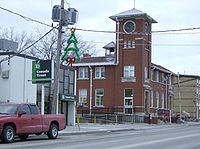Burford, Ontario
| Burford | |
|---|---|

Canada Post Office in Burford's downtown
|
|
| Coordinates: 43°6′7.92″N 80°25′44.4″W / 43.1022000°N 80.429000°W | |
| Country | Canada |
| Province | Ontario |
| County | Brant |
| Settled | 1793 |
| Area | |
| • Total | 7.76 km2 (3.00 sq mi) |
| Population (2016) | |
| • Total | 1,615 |
| • Density | 208.2/km2 (539/sq mi) |
| Time zone | Eastern (UTC-5) |
| Area code(s) | 519 and 226 |
Burford is a rural community and is part of the County of Brant, in central southwestern Ontario. It has 1,615 residents (2016 Census). It is located eight kilometers west of the City of Brantford along Highway 53, and seventy kilometers east of London, Ontario. It is approximately 100 km southwest of Toronto.
Burford is home to the Burford Bulldogs, a junior hockey team that plays in the Southern Ontario Junior Hockey League.
Burford has a local golf course, Burford Golf Links, which was founded in 1980. It has gone through a number of different owners and is now part of the GolfNorth group of golf courses.
Burford was the largest town of the former Burford Township, which included Cathcart, Harley and Princeton. Burford's ‘downtown’, the intersection of Maple Avenue and King Street (Highway 53), includes a stop light, several small businesses and a post office. The community was founded by Canadians of German, Dutch and British backgrounds. Shortly after the Rebellion of 1837, Burford was the centre of an abortive rebellion in the Western District of Upper Canada led by Charles Duncombe. In 1999, Burford became part of the County of Brant, an amalgamation of several local municipalities including Brantford Township, the town of Paris, Oakland Township, Onondaga Township and South Dumfries Township. The current mayor of the County of Brant is Ron Eddy.
Historically, when tobacco was lucrative, the farms and families surrounding Burford were relatively prosperous. However, when smoking habits began to change in the 1980s, the economy slipped into decline. Currently, farmers are more likely to be growing ginseng for oriental markets than tobacco. Dairy, poultry, hog and fish farming persist and range from large scale commercial operations to subsistence type family farms. The community has lost population since the 1970s and is eager to attract new investment.
...
Wikipedia
